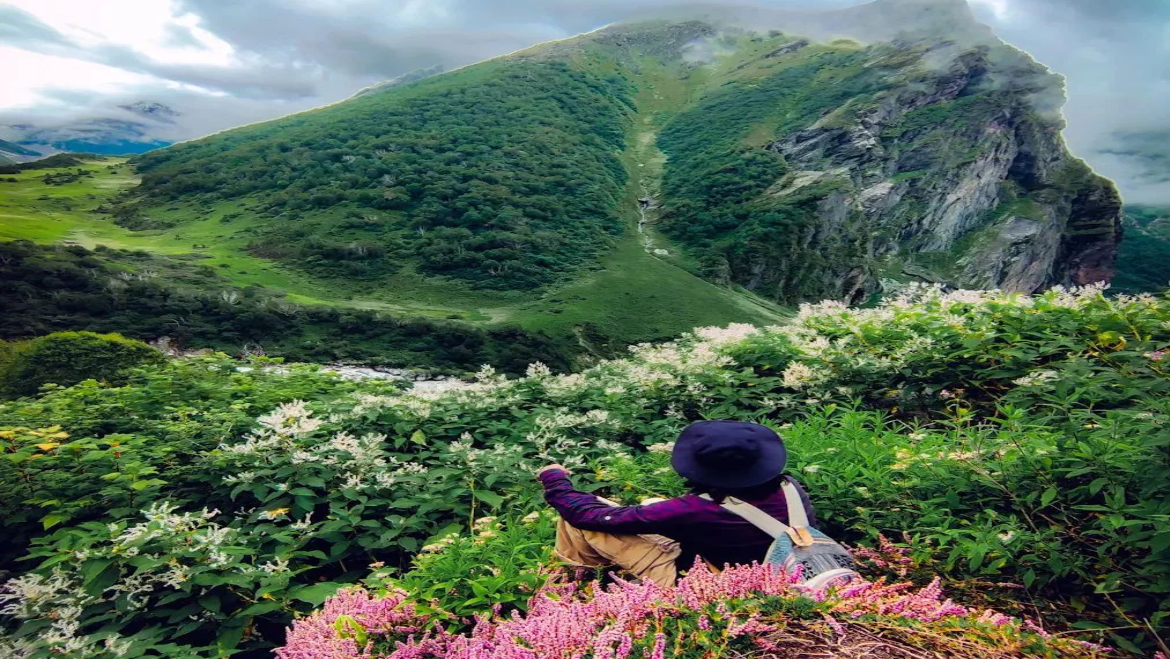The Trek
The trek towards the Valley begins at Govind Ghat, after crossing the Alaknanda river on a hanging bridge. The zig-zag mule track straightens through an ascending valley of terraced fields and vegetation. In the midst, Laxman Ganga tumbles down in a haste to join the Alaknanda. 3 kms. further is the small, pretty hamlet, Pulna. Beyond this, the trek becomes more exciting – the Laxman Ganga becomes swifter, and between the green, rocky mountains, you can catch a glimpse of snow-clad peaks.
The 7 kms. trail from Pulna to Bhyundar village is full of nature’s scenic splendors including cascading waterfalls and cold water springs. Shrubs and wild roses grow abundantly and Rhododendrons colour the area with pink and dark red. Small wayside tea stalls run all across the route and young and enthusiastic tourist guides can be engaged at Bhyundar village. After resting awhile here, the trek on the right bank of the Laxman Ganga continues through the rich vegetation till a log bridge, supported on huge boulders, is reached. Crossing over to the left bank now, the trail becomes steeper and harder and 2 kms. from here, you will reach Ghanghria, the base camp for treks to Valley of Flowers and Hemkund Sahib.
Since camping and overnight stay is not allowed in the Valley of Flowers, Ghanghria is the logical base camp for the trek.
Travel beyond Ghanghria is on foot at Nature’s pace since the entry of ponies is prohibited. The trek is subject to strict ecological discipline and the trekker is expected to be concerned about the ecosystem of the region.
After crossing a log bridge over the Laxman Ganga, 3 kms. from Ghanghria. the route of the Valley of Flowers separates from that going to Hemkund Sahib. The Laxman Ganga joins the Pushpawati river 400 mtrs. downstream.
The trek continues along Pushpawati. A couple of kilometres ahead, the river is crossed over to its right bank on another bridge and this trail goes upto the Valley of Flowers. Snow bridges can be seen spanning the river but their strength should be properly judged if they are to be used to cross the river.
Hemkund : The high altitude Hemkund lake (4329 mts.) lies in heavenly environs. A steep trek from Ghangharia leads one to this spot in about four to six hours. It is an important pilgrimage for both Hindus and Sikhs, as well as for people from other faiths. There is a Sikh Gurudwara and a Lakshman temple built on the bank of the lake. Encircled by seven snow clad peaks and their associated glaciers, it reflects its surroundings enchantingly on its crystal clear serene waters. The glaciers from Hathi Parvat and Saptrishi peaks feed the lake and a small stream called Himganga flows out of this lake.
Seasons
From late July to the end of August, the Valley begins to take on celestial dimensions. The riot of colours is awe-inspiring.
The Pedicularis, Grandiflora, Ligularia and many other yellow varieties dominate, with patterns of other colours blending in. The flowers sway to the rhythm of the monsoon breeze as it ripples across the slopes and the atmosphere is filled with an indescribable scent of plant lives.
By September, the plants start podding and the Valley dons tranquil shades of brown. But visitors during September and October get to witness the Valley in a crystal clean atmosphere-the mountain ranges shining like polished steel in the sunlight, rainwashed rocks with gurgling streams and sun-kissed meadows about to be covered soon with a spotless white sheet of snow







